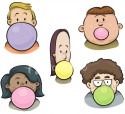Gum Recycling

Do you ever chew gum? How many times have you heard your parents or teachers tell you to put your finished gum in the garbage instead of spitting it out onto the sidewalk or leaving it under your chair? That’s good advice, since no one likes to have gum stuck to the bottom of their shoe or on their clothes or hair. Gum is sticky, and it can create a mess that is very difficult to clean up. Even in the garbage, however, gum can be a problem, since it never biodegrades. It would be far better if the gum could be reused or turned into something different. What if you could reuse gum and make it into a chair, a plastic container or fertilizer? Some scientists and inventors have found ways to turn discarded gum into many different products, and it’s helping to make cities cleaner.
Cleaning up used chewing gum might not seem like a big problem, but it can be very expensive and difficult for city governments. According to research company Euromonitor International, Canadians bought more than 15,600 tonnes of gum in 2011. Much of that gum ended up on the streets. In one small area of a Toronto sidewalk, city officials once counted 2000 gum stains. Getting rid of that much gum can be difficult because it’s so sticky.
One way to get rid of discarded gum is to use high-powered hoses that spray water and chemicals, but that can be expensive and wasteful. In Calgary, the government spends $50,000 each year on removing gum just from its light rail train stations, besides the money it spends to remove it elsewhere. The process ends up wasting a lot of water, as well as uses chemicals that might harm the environment. However, gum recycling might help to provide a solution for the problem.
One of the first people to discover a way to recycle gum was a student named Anna Bullus from England, who found a way to change gum, which is made of rubber, into plastic. She now uses this plastic to make bright pink Gumdrop Bins where people can put more of their used gum. The bins come in 250-piece and 500-piece sizes and are appearing all over the country.
Officials at the Southampton Airport in southern England, for example, claim to have the first airport in the world with gum recycling bins. Some of the gum from these bins ends up being recycled into a rubbery material used for construction and for running tracks. Some of the gum even ends up as toys. The United Kingdom already has a thousand gum bins in bus depots, train stations and other public areas. Some people estimate that the bins have reduced gum litter by 75%, and the project is still growing.
Gum recycling is also coming to other parts of the world. Gumdrop Bins have appeared in an amusement park in the United States. In Canada, a company called Envyrobubble collects gum in 1000-piece containers and recycles it into fertilizer. If the idea of gum recycling catches on, who knows where it might appear next!





Leave a comment!